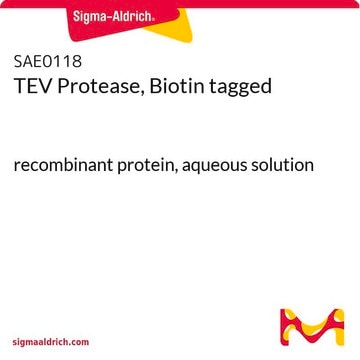SAE0110
HRV-3C Protease, Biotin tagged
Recombinant protein, 0.8-1.2 mg/mL, aqueous solution
Sinónimos:
Human Rhinovirus 3C Protease, Levlfqgp site protease, PreScission Protease
About This Item
Productos recomendados
origen biológico
human (human Rhinovirus Type 14)
recombinante
expressed in E. coli
Análisis
≥90%
formulario
aqueous solution
actividad específica
≥5000 U/mg
mol peso
22 kDa
concentración
0.8-1.2 mg/mL
técnicas
protein purification: suitable
idoneidad
suitable for protein modification
aplicaciones
life science and biopharma
Condiciones de envío
dry ice
temp. de almacenamiento
−20°C
Descripción general
This biotinylated HRV-3C protease is intended for on-column cleavage of fusion proteins with an HRV-3C cleavage site. It specifically cleaves the protein of interest from a column-bound fusion protein, leaving the fusion domain or tag bound to the affinity column (e.g. Ni-NTA column) and eluting only the protein of interest. This method is advantageous over post-elution cleavage for several reasons:
- It eliminates most impurities normally associated with purification on Ni-chelating columns.
- It allows gentler elution conditions, with added flexibility in the elution buffer composition. This can mitigate protein aggregation and inactivation.
After cleavage, the protease can be removed with any avidin-conjugated or streptavidin-conjugated beads. This product has been enzymatically biotinylated with no effect on its proteolytic activity. It has no additional protein purification tags. The product is supplied in aqueous buffer (0.8–1.2 mg/mL) with 20 mM Trizma®-HCl, pH 8.0, 200 mM NaCl, 1 mM TCEP, and 50% (v/v) glycerol.
Nota de preparación
Información legal
Código de clase de almacenamiento
10 - Combustible liquids
Clase de riesgo para el agua (WGK)
WGK 2
Punto de inflamabilidad (°F)
Not applicable
Punto de inflamabilidad (°C)
Not applicable
Certificados de análisis (COA)
Busque Certificados de análisis (COA) introduciendo el número de lote del producto. Los números de lote se encuentran en la etiqueta del producto después de las palabras «Lot» o «Batch»
¿Ya tiene este producto?
Encuentre la documentación para los productos que ha comprado recientemente en la Biblioteca de documentos.
Artículos
Proteases for biotinylated tag removal for protein purification workflows with related reagents and technical resources.
Nuestro equipo de científicos tiene experiencia en todas las áreas de investigación: Ciencias de la vida, Ciencia de los materiales, Síntesis química, Cromatografía, Analítica y muchas otras.
Póngase en contacto con el Servicio técnico








